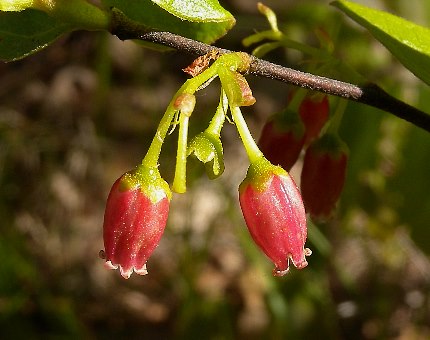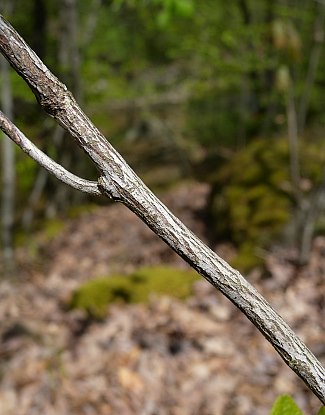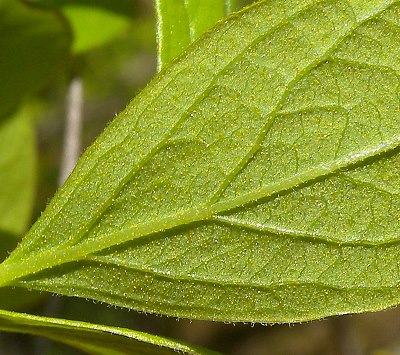Description: This low deciduous shrub is 1-3' tall, branching occasionally. Young stems are yellowish green to reddish brown, pubescent or hairless, while older stems are light gray to nearly black. The wood of the stems is relatively brittle and weak. The blades of alternate leaves are 1-2¼" long and ½-1" across; they are oblong-ovate, obovate, or narrowly oval and smooth along their margins. The upper surface of the blades is yellowish green and slightly shiny, while the lower surface is dull yellowish green and more or less covered with fine resinous dots that are yellow (more visible with a 10x hand lens). The petiole is short and slender. Short fine hairs are often present on the lower blade surface and petioles. The flowers develop in raceme-like clusters from the axils of the leaves. Individual flowers are up to 1/3" (8 mm.) long and a little less across, consisting of a short yellowish green calyx with 5 broad lobes and a tubular corolla with 5 tiny lobes along its rim that are strongly recurved. The red corolla (rarely white) is slightly constricted toward its throat, forming an urn-like shape. Each flower also has 10 inserted stamens and a pistil with a single style. The pedicels and calyces of the flowers are covered with short fine hairs and/or yellow resinous dots. The blooming period occurs from late spring to early summer, lasting about 3 weeks. Later, the flowers are replaced by globoid berries up to 1/3" (8 mm.) across. These berries are initially green, but they become blue-black at maturity. The interior of each berry is fleshy and sweet; it contains 10 seeds, which are individually up to 2 mm. long. The woody root system is shallow and branching; it can develop clonal offsets from underground runners. Colonies of plants are often produced. The leaves turn red during the autumn before falling to the ground.

Cultivation:
The
preference is partial sun, mesic to dry conditions, and an acidic soil
that is sandy or rocky. Plants that are grown in too much shade may
fail to produce flowers and fruit. The flowers are self-fertile, but
fruit production is better when there is cross-pollination.
Range & Habitat:
Black Huckleberry is a native shrub that is found primarily in northern
and southern Illinois (see Distribution
Map), where it is occasional in sandy or rocky areas.
Elsewhere in the state, it is rare or absent. Habitats consist of
upland rocky woodlands, wooded slopes, sandy savannas, openings in
sandy woodlands, sandy shrub prairies, rocky bluffs and sandstone
cliffs, sandy or rocky thickets, and stabilized sand dunes. Outside of
Illinois, this shrub is sometimes found in bogs. Because it is able to
resprout from underground runners, this shrub adapts to fire-prone
habitats. In sandy shrub prairies, it is occasionally the dominant
plant.

Faunal
Associations: The
flowers are cross-pollinated primarily by honeybees, bumblebees, mason
bees (Osmia spp.), Halictid bees, and
Andrenid bees. Other floral visitors include butterflies
and various Syrphid flies (Small, 1976; Grundel & Pavlovic, 2000;
Grundel et al., 2011; Voss, 1954). These insects seek primarily nectar
from the
flowers, although the Syrphid flies probably feed on the pollen. The
caterpillars of the butterfly, Callophrys henrici
(Henry's Elfin), feed on Black Huckleberry, as do the caterpillars of
several moths, specifically: Cyclophora pendulinaria (Sweet Fern Geometer), Melanomma auricinctaria (Huckleberry Eye-spot), Pangrapta decoralis (Decorated Owlet), Psectraglaea carnosa (Pink Sallow), Acleris curvalana (Blueberry Leaftier Moth), Zomaria interruptolineana (Broken-lined Zomaria), Sphinx gordius (Gordian Sphinx), Coptodisca magnella (a leaf-mining moth), and Phyllonorycter diversella (a
leaf-mining moth); see Bouseman & Sternburg (2001), Wagner (2005),
Panzer et al. (2006), and Needham et al. (1928). Another insect that
feeds on Black Huckleberry is an aphid, Illinoia finni (see Blackman & Eastop, 2013).

Among vertebrate
animals, the fruit is eaten by many species of upland gamebirds and
songbirds (see Bird Table).
Mammals that eat the fruit include the Fox Squirrel and American Black
Bear, while White-tailed Deer browse on the foliage, twigs, and fruit
(Martin et al., 1951/1961; Beeman & Pelton, 1980). Dense colonies
of Black
Huckleberry in sandy shrub prairies and savannas provide nesting
habitat and protective
cover for various small animals.
Photographic Location:
The photo of the flowers was taken in a sandy savanna at the Oak
Opening Nature Preserve in NW Ohio, while the photos of the leafy
shrub, twig, and leaf underside were taken in an upland rocky woodland
near a ravine at The Potholes in west-central Indiana.

Comments: The berries of huckleberries are very similar to the berries of blueberries, except the latter usually contain more seeds (8-20) that are smaller in size. The foliage and woody stems of Black Huckleberry are quite similar to those of low-bush blueberries (particularly Vaccinium pallidum), except the leaf undersides of the former shrub are covered with resinous yellow dots, while the leaf undersides of blueberries lack such resinous dots. In Illinois, Black Huckleberry is the only species in its genus, although other huckleberry species can be found in the southeastern United States.